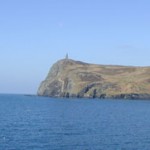Andrew J. Davies and Mark P. Johnson
Published in Estuarine, Coastal and Shelf Science (2006)
 Both climate change and the North Atlantic Oscillation (NAO) may influence coastal systems by altering wave exposure. The effects of such climatic forcing are often coherent over relatively large geographic areas. Temporal trends in wave exposure at any particular shore are, however, the result of an interaction between site-specific fetch characteristics and changes in wind climate. This leads to contrasting trends in wave exposure at locations separated by no more than a few kilometres. Wave exposures were estimated at locations around a sea lough over 32 years to characterise these scales of variability. Locations separated by approximately 5 km had independent dynamics with respect to the temporal trend (correlation range -0.35 to 0.44) and to associations with the NAO (correlation range -0.18 to 0.40). Wave exposure can therefore be increasing for a section of shore while nearby areas have the opposite trend. Mean exposure at a location was not a good predictor of the temporal trend. More exposed sites were, however, sensitive to variations in the strength of the NAO. The reduction of large scale forcing to small-scale variability has implications for the detection and mitigation of potential climate change impacts.
Both climate change and the North Atlantic Oscillation (NAO) may influence coastal systems by altering wave exposure. The effects of such climatic forcing are often coherent over relatively large geographic areas. Temporal trends in wave exposure at any particular shore are, however, the result of an interaction between site-specific fetch characteristics and changes in wind climate. This leads to contrasting trends in wave exposure at locations separated by no more than a few kilometres. Wave exposures were estimated at locations around a sea lough over 32 years to characterise these scales of variability. Locations separated by approximately 5 km had independent dynamics with respect to the temporal trend (correlation range -0.35 to 0.44) and to associations with the NAO (correlation range -0.18 to 0.40). Wave exposure can therefore be increasing for a section of shore while nearby areas have the opposite trend. Mean exposure at a location was not a good predictor of the temporal trend. More exposed sites were, however, sensitive to variations in the strength of the NAO. The reduction of large scale forcing to small-scale variability has implications for the detection and mitigation of potential climate change impacts.
Request PDF
| To request a PDF copy of this paper, please enter your email address below: Your email address is not stored, it is only used to send an email with an attached PDF to you. |
Full citation
Davies, A.J. & Johnson, M.P. (2006) “Coastline configuration disrupts large-scale climatic forcing, leading to divergent temporal trends in wave exposure” Estuarine and Coastal Shelf Science 69 (3-4): 643-648.
